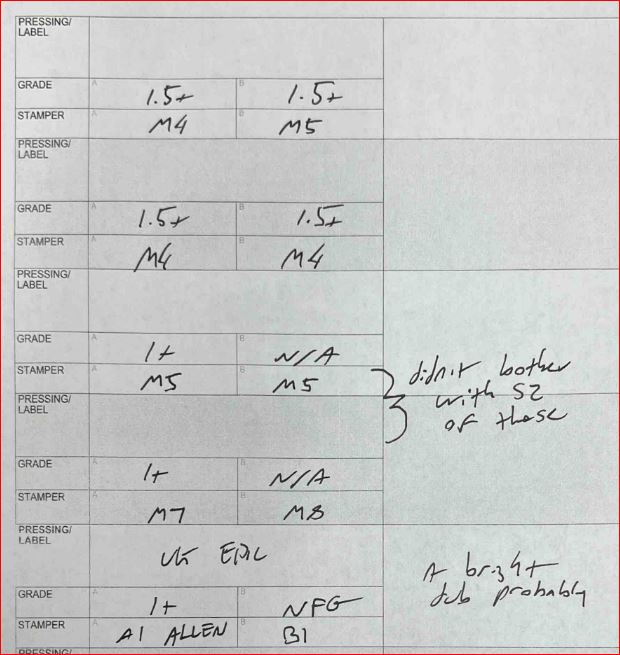 More of the Music of Carole King
More of the Music of Carole King
Reviews and Commentaries for Tapestry
The domestic pressings with the stampers shown below, and others similar to them, have not done well in our shootouts for years now. If you own a copy with these stampers, or ones like them, the good news is that we can get you a much better sounding copy of Tapestry than you have ever heard. It won’t be cheap, but we can guarantee that it will be very, very good.
Stamper numbers are not the be-all and end-all in the world of records, a subject we discuss below, but after hearing too many copies with these stampers and decidedly mediocre sound, from now on we are going to focus our attention on the stampers that do well and leave copies with these markings sitting in the bins.
Note that the last listing is for an early UK import. I have no idea how that record got into the shootout. The chances of an import doing well up against Bernie Grundman’s brilliant mastering — from back in the good old days of the 60s, 70s and 80s when he was actually doing brilliant mastering work — is so close to zero it can’t be calculated.
Sometimes we take long shots, hoping to learn something new. In this case, we learned what we already know. Yes, there are still some audiophiles who buy imports of a record like this hoping to find better sound. I can’t imagine what kind of system it would take to hide the bright, dubby sound of the UK pressing we played, but judging from some of the foolishness I read on the Hoffman forum and others of its ilk, I know there must be plenty of them out there.

Monarch is responsible for the mediocre-at-best sound of the pressings with the stampers you see above. We tend to like Monarch pressings as a rule, but sometimes they mess up, and they messed up Tapestry compared to others who pressed the record.
We liked all the other copies with other stampers better than than these, which just goes to show you can never know how good it can get until it gets that good. That is what shootouts allow us to do.
Playing close to twenty copies of Tapestry in a shootout allows us to grade Tapestry on a scale, with the M stampers filling out most of the bottom and the other stampers — wouldn’t you like to know which ones! — occupying the middle and the top of the distribution.
This is what the forum posters fail to understand. They think they have a Hot Stamper when what they actually have (maybe!) is a good sounding record. They don’t know how amazing the record can sound — so much more amazing than the one they own, probably — so they assume they have something good, maybe even the best.
They probably do not, but who really knows? The shootout would supply the data they need to support their conclusions, and since they could not be bothered to conduct one, they have no data to back up their opinions.
The “probably” you see in the above two sentences is there for a good reason. We make a point of being clear about what we can know and we cannot know, and we cannot know what a record sounds like until we play it.
This is obviously true for those of us who try to listen as critically as possible, but we also know that it is just as important to think about records the right way.
Mistaken thinking keeps audiophiles from making progress in this hobby just as much as bad equipment and bad records do.
Your Chances Go Up
Simply put, your chances of finding a used Tapestry with good sound are better if you avoid the M stamper pressings, and of course any and all imports.
When it comes to stampers, labels, mastering credits, country of origin and the like, we make a point of revealing very little of this information on the site, for a number of good reasons we discuss here.
The idea that the stampers are entirely responsible for the quality of any given record’s sound is a mistaken idea, and a rather convenient one when you stop to think about it. Audiophiles, like most everybody else on this planet, want answers.
But in the world of records, there aren’t many.
There is only the hard work that it takes to come up with the best answer you can under your present circumstances, and by that we mean: your present equipment, your present tweaks, your present room, your present electrical quality, your present listening skills, your present table setup, etcetera, etcetera.
Not to mention the present condition of your ears.
With every change to your system, the record you used to like the best could turn out to be second-rate compared to the record you used to think was second-rate but has now become first-rate. What changed? Who knows?
This, of course, drives most audiophiles crazy, so they ignore or downplay their own inconvenient findings. Instead they refuse to believe their own two ears!
The Biz
Being in the shootout business means we have no way to avoid such realities, which is why it is so easy for us to accept them.
The amateurs and professionals alike who review records for audiophiles want there to be clear-cut answers for every album they write about. Uncertainty and trade-offs upset them no end.
We recognized twenty years ago that the empirical pursuit of record knowledge, practiced scientifically, must be understood as incomplete, imperfect, and provisional.
That is not going to change no matter how upsetting anyone may find it.
We Get Letters
Quite a number of our customers have written us about our Hot Stamper pressings of Tapestry, and their letters can be found here.
Further Reading
- Improving your critical listening skills
- More rock and pop albums we think we know well
- More stamper and pressing information (you’re welcome!)
